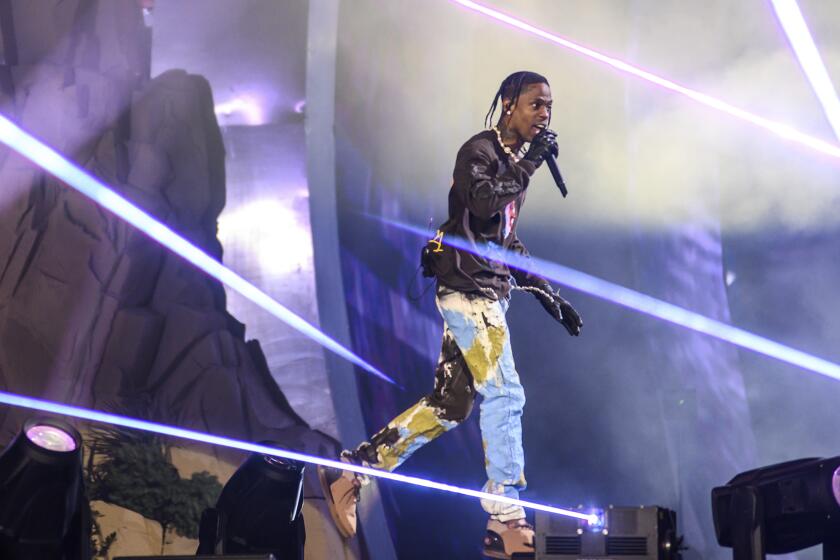Music review: Joshua Bell puts orchestra in fast lane
So what would Beethoven drive?
I’m not sure that putting anyone that headstrong behind the wheel would be a great idea. He’d likely scream at his publisher on his cellphone while driving, impatiently tailgate, cut people off. He’d speed for sure and never, ever signal.
But Orange County is car country and Thursday night at the Renée and Henry Segerstrom Concert Hall, Joshua Bell handed over the keys of his new Porsche to the composer for a high-octane spin of his “Coriolan” Overture, Violin Concerto and Fourth Symphony. Sure enough, starts were fast, breaking was hard and spurts of torque (whatever that is) were spine-tingling.
To the surprise of many, the popular 44-year-old American violinist was recently appointed music director of the decorous British chamber orchestra, Academy of St. Martin in the Fields, and they are on their first U.S. tour together. Bell’s bio in the program book notes that “millions of people” are likely to know him from his appearances on “The Tonight Show,” “Tavis Smiley,” “Charlie Rose” or “CBS Sunday Morning,” “Sesame Street” and a People magazine spread of the 50 most beautiful people. He’s made 36 classical and otherwise CDs, played on many movie soundtracks, been invited to the White House.
Conducting Beethoven may be something novel for Bell, but his new position isn’t as much of a stretch as might first seem. The ASMF was formed by Neville Marriner in 1958 as a small conductorless string ensemble. A violinist in the London Symphony Orchestra, Marriner led performances of his new group from the first violinist’s chair. Gradually, winds were added and Marriner moved up to a podium. Bell is only the second music director of the orchestra (Marriner is now life president and pianist Murray Perahia is principal guest conductor).
Like Marriner, Bell conducts from the concertmaster’s chair — or in this case, piano bench — and thus appeared to return the ASMF to its roots. (Bell was soloist in the Violin Concerto, so he stood for that.) He got such astonishingly rich string sonorities that the winds, brass and timpani sounded almost as though they had been brought in as guest artists.
The program was dead-center middle-period Beethoven. The symphony, concerto and overture have consecutive opus numbers (60, 61 and 62) and were written around the same time (1806 for symphony and concerto and 1807 for the overture). This is heroic Beethoven, triumphant Beethoven, overcoming serious crises — impending deafness, a hopeless love life — as well as emancipating music from its Classical period restrictions and the role of the creative artist from social servitude.
Bell’s Beethoven is, on the surface, gung ho. He knocked out the opening chords of the “Coriolan,” as if he were now that Porsche driver thrilled with the feeling of power and best avoided. A small orchestra sounded mighty, indeed, so much so that one might have wondered whether Bell pumped some extra air into the Segerstrom Hall sound chambers when no one was looking.
His conducting style, while seated, was basically playing the violin with great enough animation that he eggs everyone on. If the other players were watching, they were doing so out of the corner of their eyes and they didn’t let on. But the spirit was there.
While playing the Violin Concerto, Bell occasionally used his bow to cue and sometimes seemed to scoop rhythms up with his hands. Mostly, though, he attended to making a very beautiful sound on his instrument. He supplied his own cadenzas, and they were entertaining for their technical Paganini-like showmanship.
But for all that zooming through Beethoven, this was contented, not revolutionary, music making. I made the mistake of listening to violinist Gidon Kremer’s 1982 recording of the Beethoven concerto with Marriner and the ASMF the other day. Kremer supplies radical new cadenzas by the Russian composer Alfred Schnittke, and the whole performance has an intensity, attention to detail and determination to make Beethoven sound modern and meaningful that was lacking Thursday night.
In the Fourth Symphony Bell was once more gung-ho. Phases took off with a punch and landed with a hard thud. Acceleration was sure. Bell knew where he was going and how to get there. But there was an underlying blandness to much of what happened in the middle of a phrase. And there was a kind of overall conformity in the way one phrase predictably answered another.
The encore was the opening movement of Mozart’s Symphony No. 25, an ASMF calling card, and it was terrific. It did surprise. It sounded like a symphony with an unpredictable inner life. Next time, I hope Bell brings more Mozart and gives him a Ferrari.
RELATED:
VIDEO: Joshua Bell stops by Jose Andres’ Bazaar to talk food
Violinist Joshua Bell’s hotel room in Spain is burglarized
Music review: Joshua Bell and Rafael Frühbeck de Burgos at the Hollywood Bowl
¿
More to Read
The biggest entertainment stories
Get our big stories about Hollywood, film, television, music, arts, culture and more right in your inbox as soon as they publish.
You may occasionally receive promotional content from the Los Angeles Times.







